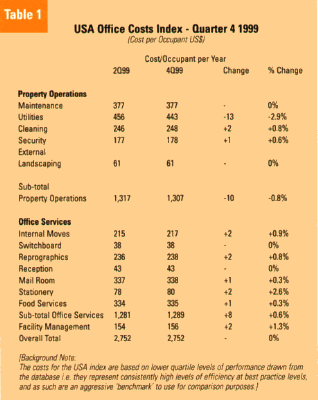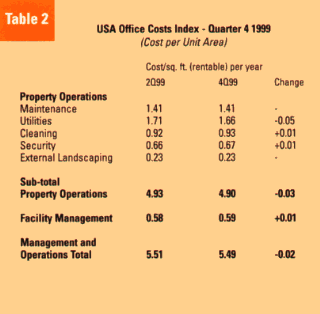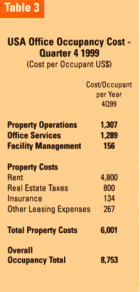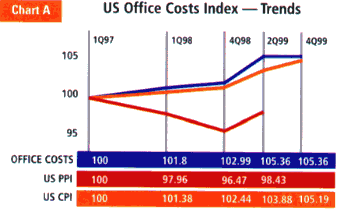The Johnson Controls USA Office Costs Index
[See Tables One, Two, Three and Chart A for data]
The Johnson Controls USA Office Occupancy Costs Index is based on a detailed model of a medium grade air-conditioned office building, which operates reasonably efficiently with no unusually high service standards or demands. The building is 160,000 rentable sq. ft. (14,800 sq. m.) in size, and houses 600 occupants working between 8a.m. and 6p.m. five days a week. Figures reported reflect changes from the 2nd Quarter 1999 (end of June) to the 4th Quarter 1999 (end of December). It does not analyze changes in the cost of rents, local taxes, service charges, insurance, depreciation, small project works, IT and any capital investments/purchases, as variations in the level of these costs are too case specific to monitor in this way. Notional sums for some of these property costs have been added in a separate analysis, however, to give a representation of the total occupancy cost for the model facility.
Costs have been measured in terms of the cost per occupant per year for all services (Table One), and in terms of cost per rentable square feet (Table Two) for those services where a building’s area can be a significant cost driver. The cost per occupant measure is considered to be the more meaningful of the two from a business perspective, as for all services it is that which is most closely aligned to the primary purpose of the facility from the user’s perspective, i.e. the productive support of people. Table Three shows, on a cost per occupant basis, a notional calculation of the total occupancy cost.
 The Index (Table One) shows that, in overall terms, it now typically costs US$2,752 each year to service an office-based employee at a place of work. Over the six-month period since the last index, this has not changed in overall terms (although component costs have). In terms of the model facility with 600 occupants, this equates to a total annual cost of $1,651,200. Adding in the property costs gives a total occupancy cost (Table Three) of $8,753 per occupant, which this equates to a total annual cost of $5,251,800 for the model facility.
The Index (Table One) shows that, in overall terms, it now typically costs US$2,752 each year to service an office-based employee at a place of work. Over the six-month period since the last index, this has not changed in overall terms (although component costs have). In terms of the model facility with 600 occupants, this equates to a total annual cost of $1,651,200. Adding in the property costs gives a total occupancy cost (Table Three) of $8,753 per occupant, which this equates to a total annual cost of $5,251,800 for the model facility.
 Key Points To Note
Key Points To Note
(4th Quarter 1999)
• Maintenance. Costs for labor have increased by approximately 1percent, but this has been negated by similar scale of decrease in the cost of materials over the six-month period.
• Energy & Water. This is currently the most volatile area of costs. Following a considerable rise during the last period, electricity costs have now decreased by 4.5 percent over the period, but gas prices have done the opposite. Following a decrease they have now risen considerably — by over 11 percent. The far greater significance of electricity costs, however, has meant that the energy and water index overall has reduced by nearly 3 percent.
• Cleaning. Similar rates of increase for both labor and consumables has pushed up costs by just under 1 percent.
• Security. Once again labor costs have risen, but the rate of increase has reduced to just 0.6 percent over the period compared to 2 percent for the previous six months.

• Internal Moves. Labor costs both for operatives and the management function continue to rise, increasing the index by nearly 1 percent over the period.
• Reprographics. Equipment costs have once again remained relatively stable, but paper costs have reversed their recent trend and have increased over the period by nearly 3 percent.
• Mail Room. Labor costs have edged up, leading to a slight increase overall of just over one quarter of one percent.
• Stationery. The rise in paper prices has increased costs by over 2.5 percent.
• Food Services. Slight increases in both labor and food costs have resulted in an overall combined increase of 0.3 percent.
• Facility Management. Labor costs for management have risen again, but at a more modest rate of 1.3 percent compared to over 4 percent for the previous period.
 Trend
Trend
Chart A shows how the Johnson Controls Office Costs Index has shown the changing level of underlying facility costs over the last three years. This clearly shows how the more modest general rate of increase in labor costs during this last six-month period, combined with the electricity cost reductions, has abruptly halted the previous upward trend. This has pegged the Office Cost Index increase back to match that of the USA Consumer Price Index (CPI) over the three years of the data, having been ahead of it for most of the time. The Office Cost Index, however, has been considerably in excess of Producer Prices (PPI), which have been decreased over the last three years.